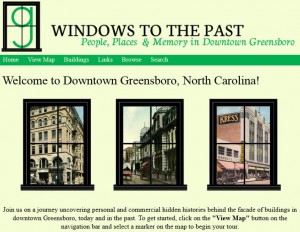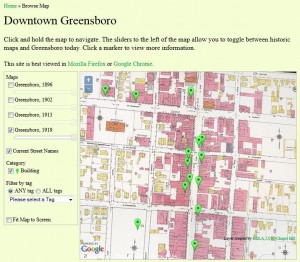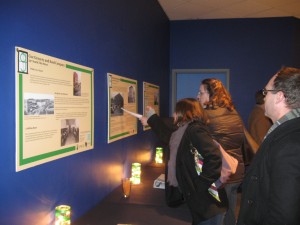The Digital Innovation Lab heartily congratulates Journalism PhD Candidate Lorraine Ahearn. Lorraine is one of this year’s recipients of the Graduate Education Advancement Board Impact Award for her work on “Windows to the Past: People, Places & Memory in Downtown Greensboro.”
The award competition, organized by UNC’s Graduate School, recognizes outstanding graduate student research of particular benefit to North Carolina.

Homepage of “Windows to the Past” digital history project.
Lorraine’s project was developed in the Digital Innovation Lab’s AMST 890: “Digital Humanities/Digital History: Recovering and Representing the Past” (Fall 2011) in collaboration with the Public History graduate program at the University of North Carolina-Greensboro under the direction of Benjamin Filene. Lorraine, along with SILS Masters student Kami LaBerge, teamed up with six graduate students at UNC-G to develop a virtual walking tour of downtown Greensboro.
The site was built with our “Main Street, Carolina” software, developed in collaboration with the Carolina Digital Library and Archives (the DIL is currently working on a new WordPress-based tool, inspired by MSC, called diPH: Digital Public Humanities Toolkit).

The digital project includes an interactive historical map, overlaid onto contemporary Google satellite imagery, with informational markers pinned to the map.
The virtual tour was part of a three-tier project to document downtown Greensboro storefronts consisting of 1) a six-month exhibit of storefront displays in sixteen buildings on Elm Street, 2) a self-guided walking tour, and 3) a virtual walking tour. The MSC site maps thirty-six historic buildings, tracing their changing uses over the years to uncover untold stories of the city’s past. Drawing on oral histories, public records, and photographs, the site represents change over time, the power of personal memory, and the links between lived experience and the built environment. As Lorraine explains, “the site enabled users, like Bennie P. Harden, Jr. to contribute to the story of the downtown. Harden, for example, recalled a performance by little-known singer, Elvis Presley, in the mid-1950s at the theater Harden’s father managed downtown.”
Lorraine and Kami worked largely virtually with the UNC-G students, providing technical guidance and consultation while helping conceptualize, organize, and create the site. Lorraine and Kami also developed a mobile version of the site that can be accessed via QR codes included on each storefront display.

Greensboro residents at the December 2011 opening reception. The storefront panels included QR codes linking to a mobile site.
The site premiered on December 2, 2011 at Greensboro’s First Friday event. At its first unveiling, “Windows to the Past,” was shown and demonstrated to hundreds of visitors who came through the opening reception. Outside the Elm Street Center in the crowded streets, closed to traffic, potentially many more pedestrians got their first look at the storefront panels. The main website received nearly 1,000 visitors in its first year, significantly higher than other MSC project sites, but this did not include the traffic to the mobile sites from the QR application.
“Windows to the Past” was made possible in part by a grant from the North Carolina Humanities Council, a statewide nonprofit and affiliate of the National Endowment for the Humanities.
As Lorraine reflects, “As exciting as the public unveiling of the website was at Greensboro’s Festival of Lights in December 2011, with storefront “Windows” panels bearing QR tags potentially seen by thousands of downtown visitors, what is still more promising is the idea that the site persists after the physical exhibit has gone.” She added, “It was a stroke of serendipity to be a small part of the interdisciplinary team which launched this website on downtown Greensboro public memory, completed in the span of a semester.”
